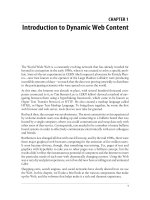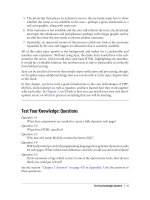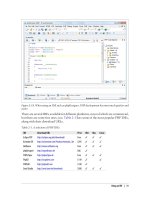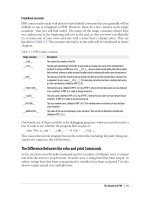Học php, mysql và javascript - p 3 ppt
Bạn đang xem bản rút gọn của tài liệu. Xem và tải ngay bản đầy đủ của tài liệu tại đây (1.44 MB, 10 trang )
CHAPTER 1
Introduction to Dynamic Web Content
The World Wide Web is a constantly evolving network that has already traveled far
beyond its conception
in the early 1990s, when it was created to solve a specific prob-
lem. State-of-the-art experiments at CERN (the European Laboratory for Particle Phys-
ics—now best known as the operator of the Large Hadron Collider) were producing
incredible amounts of data—so much that the data was proving unwieldy to distribute
to the participating scientists who were spread out across the world.
At this time, the Internet was already in place, with several hundred thousand com-
puters connected to it, so Tim Berners-Lee (a CERN fellow) devised a method of nav-
igating between them using a hyperlinking framework, which came to be known as
Hyper Text Transfer Protocol, or HTTP. He also created a markup language called
HTML, or Hyper Text Markup Language. To bring these together, he wrote the first
web browser and web server, tools that we now take for granted.
But back then, the concept was revolutionary. The most connectivity so far experienced
by at-home modem users was dialing up and connecting to a bulletin board that was
hosted by a single computer, where you could communicate and swap data only with
other users of that service. Consequently, you needed to be a member of many bulletin
board systems in order to effectively communicate electronically with your colleagues
and friends.
But Berners-Lee changed all that with one fell swoop, and by the mid 1990s, there were
three major graphical web browsers competing for the attention of five million users.
It soon became obvious, though, that something was missing. Yes, pages of text and
graphics with hyperlinks to take you to other pages was a brilliant concept, but the
results didn’t reflect the instantaneous potential of computers and the Internet to meet
the particular needs of each user with dynamically changing content. Using the Web
was a very dry and plain experience, even if we did now have scrolling text and animated
GIFs!
Shopping carts, search engines, and social networks have clearly altered how we use
the Web. In this chapter, we’ll take a brief look at the various components that make
up the Web, and the software that helps make it a rich and dynamic experience.
1
It is necessary to start using some acronyms more or less right away. I
have tried to clearly explain them before proceeding. But don’t worry
too much about what they stand for or what these names mean, because
the details will all become clear as you read on.
HTTP and HTML: Berners-Lee’s Basics
HTTP is a communication standard governing the requests and responses that take
place between the browser running on the end user’s computer and the web server.
The server’s job is to accept a request from the client and attempt to reply to it in a
meaningful way, usually by serving up a requested web page—that’s why the term
server is used. The natural counterpart to a server is a client, so that term is applied
both to the web browser and the computer on which it’s running.
Between the client and the server there can be several other devices, such as routers,
proxies, gateways, and so on. They serve different roles in ensuring that the requests
and responses are correctly transferred between the client and server. Typically, they
use the Internet to send this information.
A web server can usually handle multiple simultaneous connections and—when not
communicating with a client—spends its time listening for an incoming connection.
When one arrives, the server sends back a response to confirm its receipt.
The Request/Response Procedure
At its most basic level, the request/response process consists of a web browser asking
the web server to send it a web page and the server sending back the page. The browser
then takes care of displaying the page (see Figure 1-1).
Each step in the request and response sequence is as follows:
1. You enter into your browser’s address bar.
2. Your browser looks up the IP address for server.com.
3. Your browser issues a request for the home page at server.com.
4. The request crosses the Internet and arrives at the server.com web server.
5. The web server, having received the request, looks for the web page on its hard disk.
6. The web page is retrieved by the server and returned to the browser.
7. Your browser displays the web page.
For an average web page, this process takes place once for each object within the page:
a graphic, an embedded video or Flash file, and even a CSS template.
In step 2, notice that the browser looked up the IP address of server.com. Every machine
attached to the Internet has an IP address—your computer included. But we generally
access web servers by name, such as google.com. As you probably know, the browser
2 | Chapter 1: Introduction to Dynamic Web Content
consults an additional Internet service called the Domain Name Service (DNS) to find
its associated IP address and then uses it to communicate with the computer.
For dynamic web
pages, the procedure is a little more involved, because it may bring
both PHP and MySQL into the mix (see Figure 1-2).
1. You enter into your browser’s address bar.
2. Your browser looks up the IP address for server.com.
3. Your browser issues a request to that address for the web server’s home page.
4. The request crosses the Internet and arrives at the server.com web server.
5. The web server, having received the request, fetches the home page from its hard
disk.
6. With the home page now in memory, the web server notices that it is a file incor-
porating PHP scripting and passes the page to the PHP interpreter.
7. The PHP interpreter executes the PHP code.
8. Some of the PHP contains MySQL statements, which the PHP interpreter now
passes to the MySQL database engine.
9. The MySQL database returns the results of the statements back to the PHP
interpreter.
Figure 1-1. The basic client/server request/response sequence
HTTP and HTML: Berners-Lee’s Basics | 3
10. The PHP interpreter returns the results of the executed PHP code, along with the
results from the MySQL database, to the web server.
11. The web server returns the page to the requesting client, which displays it.
Although
it’s helpful to be aware of this process so that you know how the three ele-
ments work together, in practice you don’t really need to concern yourself with these
details, because they all happen automatically.
HTML pages returned to the browser in each example may well contain JavaScript,
which will be interpreted locally by the client, and which could initiate another
request—the same way embedded objects such as images would.
Figure 1-2. A dynamic client/server request/response sequence
4 | Chapter 1: Introduction to Dynamic Web Content
The Benefits of PHP, MySQL, and JavaScript
At the start of this chapter, I introduced the world of Web 1.0, but it wasn’t long before
the rush was on to create Web 1.1, with the development of such browser enhance-
ments as Java, JavaScript, JScript (Microsoft’s slight variant of JavaScript) and ActiveX.
On the server side, progress was being made on the Common Gateway Interface (CGI)
using scripting languages such as Perl (an alternative to the PHP language) and server-
side scripting—inserting the contents of one file (or the output of a system call) into
another one dynamically.
Once the dust had settled, three main technologies stood head and shoulders above
the others. Although Perl was still a popular scripting language with a strong following,
PHP’s simplicity and built-in links to the MySQL database program had earned it more
than double the number of users. And JavaScript, which had become an essential part
of the equation for dynamically manipulating CSS (Cascading Style Sheets) now took
on the even more muscular task of handling the client side of the Ajax process. Under
Ajax, web pages perform data handling and send requests to web servers in the back-
ground—without the web user being aware that this is going on.
No doubt the symbiotic nature of PHP and MySQL helped propel them both forward,
but what attracted developers to them in the first place? The simple answer has to be
the ease with which you can use them to quickly create dynamic elements on websites.
MySQL is a fast and powerful yet easy-to-use database system that offers just about
anything a website would need in order to find and serve up data to browsers. When
PHP allies with MySQL to store and retrieve this data, you have the fundamental parts
required for the development of social networking sites and the beginnings of Web 2.0.
Using PHP
With PHP, it’s a simple matter to embed dynamic activity in web pages. When you give
pages the .php extension, they have instant access to the scripting language. From a
developer’s point of view, all you have to do is write code such as the following:
<?php
echo "Hello World. Today is ".date("l").". ";
?>
How are you?
The opening <?php tells the web server to allow the PHP program to interpret all the
following code up to the ?> command. Outside of this construct, everything is sent to
the client as direct HTML. So the text “How are you?” is simply output to the browser;
within the PHP tags, the built-in date function displays the current day of the week
according to the server’s system time.
The final output of the two parts looks like this:
Hello World. Today is Wednesday. How are you?
The Benefits of PHP, MySQL, and JavaScript | 5
PHP is a flexible language, and some people prefer to place the PHP construct directly
next to PHP code, like this:
Hello World. Today is <?php echo date("l"); ?>. How are you?
There are also other ways of formatting and outputting information, which I’ll explain
in the chapters on PHP. The point is that with PHP, web developers have a scripting
language that although not as fast as compiling your code in C or a similar language,
is incredibly speedy and that also integrates seamlessly with HTML code.
If you intend to type in the PHP examples in this book to work along
with me, you
must remember to add <?php in front and ?> after them to
ensure that the PHP interpreter processes them. To facilitate this, you
may wish to prepare a file called example.php with those tags in place.
Using PHP, you have unlimited control over your web server. Whether you need to
modify HTML on the fly, process a credit card, add user details to a database, or fetch
information from a third-party website, you can do it all from within the same PHP
files in which the HTML itself resides.
Using MySQL
Of course, there’s not a lot of point to being able to change HTML output dynamically
unless you also have a means to track the changes that users make as they use your
website. In the early days of the Web, many sites used “flat” text files to store data such
as usernames and passwords. But this approach could cause problems if the file wasn’t
correctly locked against corruption from multiple simultaneous accesses. Also, a flat
file can get only so big before it becomes unwieldy to manage—not to mention the
difficulty of trying to merge files and perform complex searches in any kind of reason-
able time.
That’s where relational databases with structured querying become essential. And
MySQL, being free to use and installed on vast numbers of Internet web servers, rises
superbly to the occasion. It is a robust and exceptionally fast database management
system that uses English-like commands.
The highest level of MySQL structure is a database, within which you can have one or
more tables that contain your data. For example, let’s suppose you are working on a
table called users, within which you have created columns for surname, firstname, and
email, and you now wish to add another user. One command that you might use to do
this is:
INSERT INTO users VALUES('Smith', 'John', '');
Of course, as mentioned earlier, you will have issued other commands to create the
database and table and to set up all the correct fields, but the INSERT command here
shows how simple it can be to add new data to a database. The INSERT command is an
6 | Chapter 1: Introduction to Dynamic Web Content
example of SQL (which stands for “Structured Query Language”), a language designed
in the early 1970s and reminiscent of one of the oldest programming languages,
COBOL. It is well suited, however, to database queries, which is why it is still in use
after all this time.
It’s equally easy to look up data. Let’s assume that you have an email address for a user
and need to look up that person’s name. To do this, you could issue a MySQL query
such as:
SELECT surname,firstname FROM users WHERE email='';
MySQL will then return Smith, John and any other pairs of names that may be associated
with that email address in the database.
As you’d expect, there’s quite a bit more that you can do with MySQL than just simple
INSERT and SELECT commands. For example, you can join multiple tables according to
various criteria, ask for results in a variety of different orders, make partial matches
when you know only part of the string that you are searching for, return only the nth
result, and a lot more.
Using PHP, you can make all these calls directly to MySQL without having to run the
MySQL program yourself or use its command-line interface. This means you can save
the results in arrays for processing and perform multiple lookups, each dependent on
the results returned from earlier ones, to drill right down to the item of data you need.
For even more power, as you’ll see later, there are additional functions built right in to
MySQL that you can call up for common operations and extra speed.
Using JavaScript
The oldest of the three core technologies in this book, JavaScript, was created to enable
scripting access to all the elements of an HTML document. In other words, it provides
a means for dynamic user interaction such as checking email address validity in input
forms, displaying prompts such as “Did you really mean that?”, and so on (although it
cannot be relied upon for security) which should always be performed on the web
server.
Combined with CSS, JavaScript is the power behind dynamic web pages that change
in front of your eyes rather than when a new page is returned by the server.
However, JavaScript can also be tricky to use, due to some major differences among
the ways different browser designers have chosen to implement it. This mainly came
about when some manufacturers tried to put additional functionality into their brows-
ers at the expense of compatibility with their rivals.
Thankfully, the manufacturers have mostly now come to their senses and have realized
the need for full compatibility between each other, so web developers don’t have to
write multiexception code. But there remain millions of legacy browsers that will be in
use for a good many years to come. Luckily, there are solutions for the incompatibility
The Benefits of PHP, MySQL, and JavaScript | 7
problems, and later in this book we’ll look at libraries and techniques that enable you
to safely ignore these differences.
For now, let’s take a quick look at how you can use basic JavaScript, accepted by all
browsers:
<script type="text/javascript">
document.write("Hello World. Today is " + Date() );
</script>
This code snippet tells the web browser to interpret everything within the script tags
as JavaScript, which the browser then does by writing the text “Hello World. Today
is ” to the current document, along with the date, by using the JavaScript function
Date. The result will look something like this:
Hello World. Today is Sun Jan 01 2012 14:14:00
It’s worth knowing that unless you need to specify an exact version of
JavaScript, you can
normally omit the type="text/javascript" and just
use <script> to start the interpretation of the JavaScript.
As previously mentioned, JavaScript was originally developed to offer dynamic control
over the various elements within an HTML document, and that is still its main use. But
more and more, JavaScript is being used for Ajax. This is a term for the process of
accessing the web server in the background. (It originally meant “Asynchronous Java-
Script and XML,” but that phrase is already a bit outdated.)
Ajax is the main process behind what is now known as Web 2.0 (a term coined by Tim
O’Reilly, the founder and CEO of this book’s publishing company), in which web pages
have started to resemble standalone programs, because they don’t have to be reloaded
in their entirety. Instead, a quick Ajax call can pull in and update a single element on
a web page, such as changing your photograph on a social networking site or replacing
a button that you click with the answer to a question. This subject is fully covered in
Chapter 18.
The Apache Web Server
There’s actually a fourth hero in the dynamic Web, in addition to our triumvirate of
PHP, MySQL, and JavaScript: the web server. In the case of this book, that means the
Apache web server. We’ve discussed a little of what a web server does during the HTTP
server/client exchange, but it actually does much more behind the scenes.
For example, Apache doesn’t serve up just HTML files—it handles a wide range of
files, from images and Flash files to MP3 audio files, RSS (Really Simple Syndication)
feeds, and so on. To do this, each element a web client encounters in an HTML page
is also requested from the server, which then serves it up.
8 | Chapter 1: Introduction to Dynamic Web Content
But these objects don’t have to be static files such as GIF images. They can all be
generated by programs such as PHP scripts. That’s right: PHP can even create images
and other files for you, either on the fly or in advance to serve up later.
To do this, you normally have modules either precompiled into Apache or PHP or called
up at runtime. One such module is the GD library (short for Graphics Draw), which
PHP uses to create and handle graphics.
Apache also supports a huge range of modules of its own. In addition to the PHP
module, the most important for your purposes as a web programmer are the modules
that handle security. Other examples are the Rewrite module, which enables the web
server to handle a varying range of URL types and rewrite them to its own internal
requirements, and the Proxy module, which you can use to serve up often-requested
pages from a cache to ease the load on the server.
Later in the book, you’ll see how to actually use some of these modules to enhance the
features provided by the three core technologies.
About Open Source
Whether or not being open source is the reason these technologies are so popular has
often been debated, but PHP, MySQL, and Apache are the three most commonly used
tools in their categories (web scripting languages, databases, and web servers).
What can be said, though, is that being open source means that they have been devel-
oped in the community by teams of programmers writing the features they themselves
want and need, with the original code available for all to see and change. Bugs can be
found and security breaches can be prevented before they happen.
There’s another benefit: all these programs are free to use. There’s no worrying about
having to purchase additional licenses if you have to scale up your website and add
more servers. And you don’t need to check the budget before deciding whether to
upgrade to the latest versions of these products.
In fact, we’ll cover a few other add-on products in this book that you’ll find invaluable
in getting the best out of your websites. They, too, are all open source. Of course,
professional support is available to purchase for all these products, should you need
it—but that shouldn’t be the case for you once you’ve read this book.
Bringing It All Together
The real beauty of PHP, MySQL, and JavaScript is the wonderful way in which they all
work together to produce dynamic web content: PHP handles all the main work on the
web server, MySQL manages all the data, and JavaScript looks after web page presen-
tation. JavaScript can also talk with your PHP code on the web server whenever it needs
to update something (either on the server or on the web page).
Bringing It All Together | 9
Without using program code, it’s a good idea at this point to summarize the contents
of this chapter
by looking at the process of combining all three technologies into an
everyday Ajax feature that many websites use: checking whether a desired username
already exists on the site when a user is signing up for a new account. A good example
of this can be seen with Google Mail (see Figure 1-3).
The steps involved in this Ajax process would be similar to the following:
1. The server outputs the HTML to create the web form, which asks for the necessary
details, such as username, first name, last name, and email address.
2. At the same time, the server attaches some JavaScript to the HTML to monitor the
username input box and check for two things: (a) whether some text has been typed
into it, and (b) whether the input has been deselected because the user has clicked
on another input box.
3. Once the text has been entered and the field deselected, in the background the
JavaScript code passes the username that was typed in back to a PHP script on the
web server and awaits a response.
4. The web server looks up the username and replies back to the JavaScript regarding
whether that name has already been taken.
Figure 1-3. Gmail uses Ajax to check the availability of usernames
10 | Chapter 1: Introduction to Dynamic Web Content









